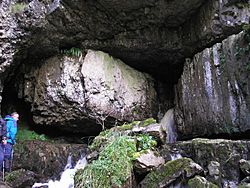Great Douk Cave facts for kids
Quick facts for kids Great Douk Cave |
|
|---|---|

Entrance to Great Douk Cave
|
|
| Location | Chapel-le-Dale, Ingleborough |
| Length | 914 metres (2,999 ft) |
| Discovery | first through trip 1936 |
| Geology | Carboniferous limestone |
| Entrances | 4 (excluding Southerscales Pot) |
| Difficulty | Easy - no pitches or difficulties |
| Hazards | Flooding |
| Access | Permission by landowner |
Great Douk Cave is a cool cave system in North Yorkshire, England. It's found under a big limestone area called Ingleborough, near a place called Chapel-le-Dale.
Many people, especially beginners and school groups, love exploring this cave. It's easy to navigate! You can follow a stream from a small waterfall entrance all the way to another entrance about 600 meters (or 656 yards) up the hill. It's also part of the Ingleborough area, which is a special place for nature and science.
Contents
Exploring Great Douk Cave
The main way into Great Douk Cave is through a big dip in the ground. At the bottom of this dip, you'll find the entrance to Great Douk Pot. There's also a clear entrance where a waterfall comes out of the cave.
Getting Inside the Cave
You can enter the cave by carefully climbing up the waterfall. Another way is to crawl through a flat, open space just above it.
Once inside, if you go left, you'll find a low passage. This leads to where the stream from Southerscales Pot flows out of a short underwater section. If you go straight, it's an easy walk. You'll pass under Little Douk Pot, which is another way to get into the cave.
Inside the Passages
As you continue, you'll see a series of pretty waterfalls. The passage also goes through areas with beautiful flowstone. Flowstone is a type of rock formation that looks like frozen waterfalls.
Soon after, you'll reach an oxbow passage. This is a shortcut that lets you avoid a low, wet crawl in the stream. After this, the passage splits into two paths.
The main path is to the left. It gets lower, becoming a flat, wide area where most of the water flows in from a small passage on the left. If you go straight, the passage gets blocked. However, a hole in the roof leads to a dry, flat area. This area then leads to another split in the path. Turning left here takes you to the Middle Washfold entrances.
History of Great Douk Cave
People have probably known about Great Douk Cave for a very long time. One of the first mentions of it was in a book from 1780 by John Hutton. He and his group explored about 50 meters (or 55 yards) past the Little Douk Pot opening.
After that, visiting the cave entrance became a popular thing for tourists to do. It was even mentioned in a travel guide from 1853.
Further Exploration
In 1850, a guide book by Howson said it was possible to go about 700 yards (or 640 meters) beyond Little Douk. Later, in 1888, the Balderstons wrote that the cave could be explored to where the underground river "has its branches." This means they got within about 100 yards (or 91 meters) of the exit at Middle Washfold.
Connecting the Passages
The full connection between Great Douk Cave and Middle Washfold was made on August 1, 1936. This was done by Norman Thornber, E.J. Douglas, and F. King.
Later, in February 1966, members of the University of Leeds Speleological Society (ULSA) connected the cave to Middle Washfold Sink.
The connection with Southerscales Pot was also made in 1966. This happened after the University of Leeds Speleological Society explored Southerscales Pot. Members of the Cave Diving Group then made the final connection.
What Does "Douk" Mean?
The word Douk appears in the names of many caves and places in the Yorkshire Dales. For example, there's Low Douk, Douk Gill Cave, Dowkabottom Cave, and High Douk Cave.
One idea for the meaning of Douk is "damp, wet, or mist." This was suggested by Smith in his 1961 book about place names. However, William Carr, in an 1828 book about the local dialect, said Douk means "To bathe, to duck."
The cave was first called 'Great Douk Cave' in a book from 1892 by Harry Speight. Before that, it was often just called 'Douk Cave'. However, William Stott Banks did mention "great and little Douk" in his 1866 book.
Gallery





